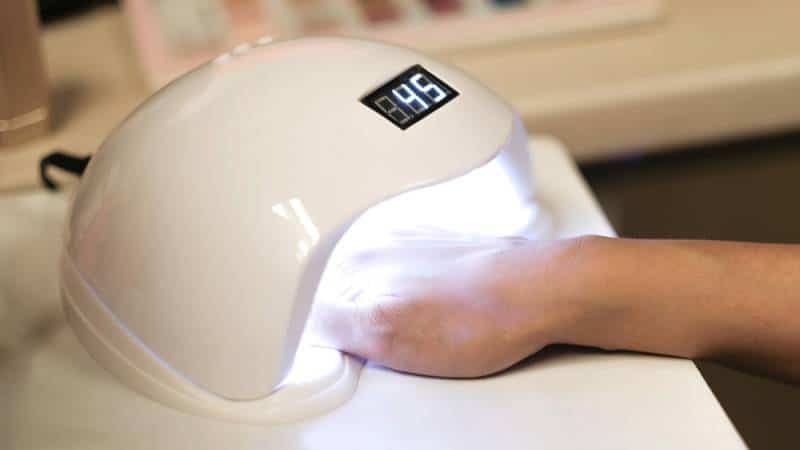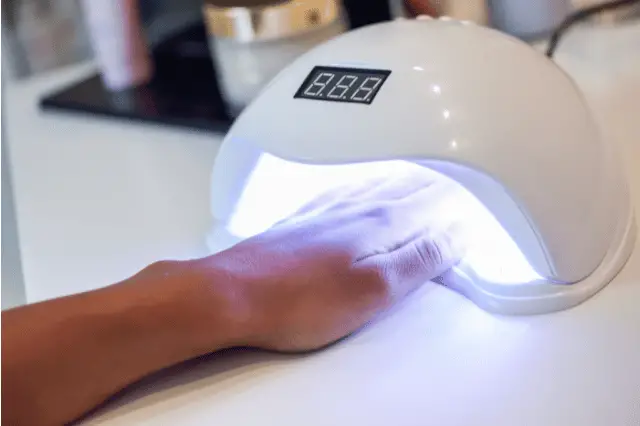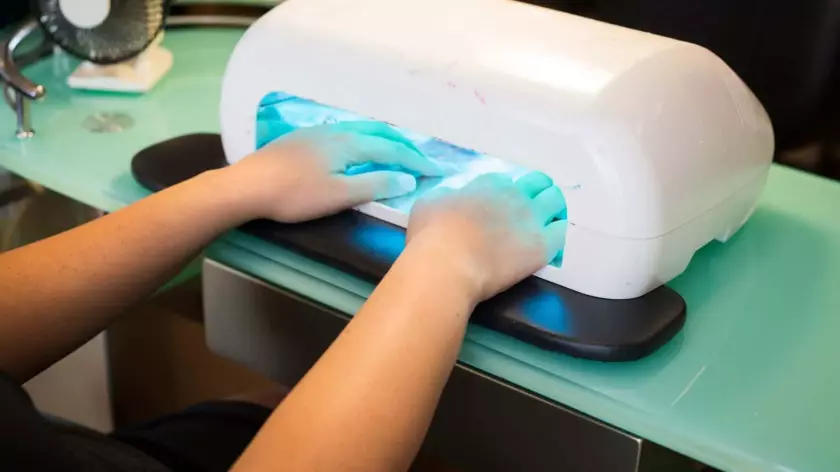Acrylic nails have gained immense popularity in the world of manicures. But do they require UV light to cure? The answer is no. Unlike gel nails, which need UV light to harden, acrylic nails are created by mixing a liquid monomer with a powder polymer, forming a paste that hardens on its own. This makes acrylic nails a convenient and versatile option for those who prefer a non-UV curing method.

UV Light vs. LED Light: Which is Best for Acrylic Nails?
When it comes to applying acrylic nails, one of the most important steps is curing the acrylic material. This is where UV (ultraviolet) or LED (light-emitting diode) lights come into play. Both types of lights are commonly used in nail salons and for at-home nail enthusiasts, but which one is truly the best option?
Let’s dive into the differences between UV lights and LED lights when it comes to curing acrylic nails, so you can make an informed decision for your nail needs.
1. UV Light
UV lights have been a staple in the nail industry for quite some time. These lights emit ultraviolet rays that initiate the chemical reaction needed to cure acrylic nails. Here are some key points to consider:
- Wavelength: UV lights typically emit a broad spectrum of wavelengths, including UVA and UVB rays.
- Curing Time: The curing process with UV lights generally takes longer compared to LED lights. It can take anywhere from 2 to 3 minutes per coat of acrylic.
- Compatibility: UV lights are compatible with all types of gel polish and acrylic products.
- Replacement Bulbs: Over time, UV bulbs may need to be replaced to maintain their effectiveness. These bulbs can be more expensive and require professional installation.
While UV lights have been a trusted choice for years, they do come with a few drawbacks. The longer curing time can be inconvenient for those seeking quick results, and the potential exposure to UVA and UVB rays may raise concerns for some individuals.
2. LED Light
LED lights, on the other hand, are a relatively newer technology in the nail industry. These lights utilize light-emitting diodes to cure acrylic nails. Here’s what you need to know:
- Wavelength: LED lights emit a narrower spectrum of light, focusing primarily on the visible light spectrum.
- Curing Time: LED lights offer a much faster curing process compared to UV lights. It usually takes only 30 to 60 seconds per coat of acrylic.
- Compatibility: LED lights work well with most gel polishes and some types of acrylic products. However, not all brands or types of acrylics are compatible with LED lights, so it’s important to check the product’s instructions.
- Longevity and Maintenance: LED lights have a longer lifespan and do not require frequent bulb replacements. They are also generally more energy-efficient.
LED lights are known for their quick curing time, which is a major advantage for busy individuals who want to get their nails done efficiently. Additionally, the reduced exposure to UVA and UVB rays can provide peace of mind for those who are concerned about the potential health risks associated with UV light exposure.
So, Which is Best?
Ultimately, the decision between UV lights and LED lights for acrylic nails depends on your specific preferences and needs. Here’s a quick summary of the key differences:
- UV lights offer a broader spectrum of wavelengths but have longer curing times. They are compatible with all types of gel polish and acrylic products but may require bulb replacements.
- LED lights emit a narrower spectrum of light, cure nails faster, and have a longer lifespan. However, compatibility with acrylic products may vary.
Consider factors such as curing time, compatibility with your preferred products, potential health risks, and budget when making your decision. It’s always a good idea to consult with a professional nail technician or refer to product instructions for guidance.
Remember, whether you choose UV lights or LED lights, proper application techniques and regular maintenance are key to achieving long-lasting and beautiful acrylic nails.

How to Cure Acrylic Nails Without UV Light
If you love having beautiful, long-lasting acrylic nails, you may have wondered if there is a way to cure them without using a UV light. While UV lights are commonly used in salons to cure acrylic nails, there are alternative methods you can try at home. In this section, we will explore some effective ways to cure acrylic nails without UV light.
1. Air Drying
Air drying is one method that you can use to cure your acrylic nails without a UV light. After applying the acrylic nail product, allow your nails to air dry naturally. This process may take longer compared to using a UV light, but it can still provide satisfactory results. Be patient and give your nails enough time to fully harden and dry.
2. Cold Water Bath
Another method to cure acrylic nails without UV light is by using a cold water bath. After applying the acrylic nail product, fill a bowl with cold water and ice cubes. Submerge your nails in the cold water for 2-3 minutes. The cold temperature helps to harden and cure the acrylic. After the bath, gently pat your nails dry with a towel.
3. LED Lamp
If you don’t have a UV light but have access to an LED lamp, you can use it to cure your acrylic nails. LED lamps emit a different type of light that can cure acrylic nails effectively. Apply the acrylic nail product as usual and place your nails under the LED lamp for the recommended curing time. Remember to read the instructions on your LED lamp for the optimal curing time.
4. Natural Sunlight
If you prefer a more natural approach, you can cure your acrylic nails using natural sunlight. Apply the acrylic nail product and then expose your nails to direct sunlight for a sufficient period of time. It is important to note that the curing time may vary depending on the intensity of the sunlight and the specific brand of acrylic products you are using.
5. Quick-Drying Top Coat
A quick-drying top coat can also help to cure your acrylic nails without UV light. Apply the acrylic nail product as usual and then apply a quick-drying top coat over it. These top coats are formulated to dry quickly and provide a hardened finish to your nails. Follow the instructions on the top coat product for the best results.
6. Patience is Key
Regardless of the method you choose to cure your acrylic nails without UV light, patience is key. It is important to allow enough time for the acrylic to fully harden and cure. Rushing the process may result in smudged or damaged nails. Take your time and follow the instructions provided by the acrylic nail product manufacturer for the best results.
In summary, while UV lights are commonly used to cure acrylic nails, there are alternative methods available. By using air drying, a cold water bath, an LED lamp, natural sunlight, or a quick-drying top coat, you can enjoy beautifully cured acrylic nails without the need for a UV light. Remember to be patient and allow enough time for the curing process. Now you can experiment with these methods and find the one that works best for you.

Potential Risks and Side Effects of UV Light in Acrylic Nail Application
Acrylic nails have become increasingly popular over the years, thanks to their durability and long-lasting nature. One key step in the application process of acrylic nails involves curing the product with UV light. While UV light is essential for setting the acrylic and ensuring a strong bond, it is important to be aware of the potential risks and side effects associated with its use.
1. Skin Damage
Exposure to UV light can lead to skin damage, including sunburn, premature aging, and an increased risk of skin cancer. The hands and surrounding areas are particularly susceptible to these harmful effects since they are directly exposed to the UV light during the application process. To minimize the risk, it is crucial to apply a broad-spectrum sunscreen with a high SPF to protect the skin from UV radiation.
2. Nail Weakness and Damage
Excessive exposure to UV light can weaken the natural nails, making them brittle and prone to breakage. It can also cause the acrylic nails to lift or peel off prematurely. To prevent this, it is recommended to limit the time spent under the UV lamp and follow the manufacturer’s guidelines for curing the acrylic products.
3. Eye Irritation and Damage
UV light can be harmful to the eyes, leading to irritation, dryness, and even long-term damage. It is crucial to protect the eyes during the acrylic nail application process by wearing UV-blocking goggles or using a protective shield to cover the eyes.
4. Allergic Reactions
Some individuals may develop allergic reactions to the chemicals present in acrylic nails or the UV gel used for curing. This can manifest as redness, itching, swelling, or even blisters on the skin surrounding the nails. If any signs of an allergic reaction occur, it is important to seek medical attention immediately and discontinue the use of acrylic nails.
5. Skin Sensitivity
UV light can cause increased sensitivity of the skin, making it more prone to irritation and allergic reactions. People with pre-existing skin conditions or those who are prone to sensitivity should exercise caution when using UV light for acrylic nail application.
Summary
While UV light is an integral part of the acrylic nail application process, it is essential to be aware of the potential risks and side effects associated with its use. Skin damage, nail weakness, eye irritation, allergic reactions, and increased skin sensitivity are among the possible adverse effects. By following proper safety precautions, limiting exposure time, and maintaining good nail care practices, these risks can be minimized, ensuring a safe and enjoyable acrylic nail experience.
Alternatives to UV Light for Acrylic Nails
Acrylic nails have become a popular choice for those who want to enhance the appearance of their natural nails. They provide a durable and long-lasting finish that can withstand daily wear and tear. One common method for curing acrylic nails is by using UV light. However, there are concerns about the potential harm that UV light can cause to the skin, as it is a form of radiation. Fortunately, there are alternatives to UV light that can be used to cure acrylic nails without compromising safety.
LED Light
LED light is one of the most popular alternatives to UV light for curing acrylic nails. LED lamps emit a different type of light that is safer for the skin. They produce less heat and do not expose the skin to harmful UV radiation. LED lamps also have a shorter curing time, which means that you can have perfectly cured acrylic nails in less time compared to using UV light.
LED lamps are available in different sizes and shapes, making it easy to find one that suits your needs. They are also portable and can be easily carried around, allowing for convenient at-home use or for professional nail technicians who may need to travel with their equipment.
UV/LED Hybrid Lamp
Another option for curing acrylic nails is using a UV/LED hybrid lamp. These lamps offer the best of both worlds by combining UV and LED technology. They emit a combination of UV and LED light, providing a safe and efficient curing process.
The advantage of using a UV/LED hybrid lamp is that it can cure all types of gel products, not just acrylic nails. This makes it a versatile option for those who like to experiment with different nail treatments.
Air Dry Method
If you prefer to avoid using any type of light to cure your acrylic nails, you can opt for the air dry method. This method involves applying a special air-dry top coat over the acrylic nails, which dries naturally in the air.
The air dry method takes longer compared to using a lamp, as it relies on evaporation for the nails to dry. However, it does not pose any risk of UV exposure and can be a suitable option for those with sensitive skin or who have concerns about UV radiation.
Heat-Activated Systems
Heat-activated systems are another alternative to UV light for curing acrylic nails. These systems use heat to cure the acrylic, rather than relying on light. The heat can be generated using specialized heating pads or devices.
While heat-activated systems may take slightly longer than UV or LED lamps to cure the acrylic, they provide a safe and effective method that eliminates the need for UV exposure.
Summary
When it comes to choosing an alternative to UV light for curing acrylic nails, there are several options available. LED light is a popular choice due to its safety and efficiency. UV/LED hybrid lamps offer versatility and can cure a variety of gel products. The air dry method provides a UV-free option that is suitable for those with sensitive skin. Lastly, heat-activated systems use heat rather than light to cure acrylic nails. Consider your individual needs and preferences when selecting an alternative to UV light for your acrylic nails.
FAQs
Do acrylic nails need UV light?
No, acrylic nails do not require UV light to cure. Acrylic nails are created by mixing a liquid monomer with a powdered polymer, which forms a paste that hardens when exposed to air. UV light is typically used in the gel manicure process.
Conclusion
In conclusion, acrylic nails do not require UV light for application. They are created by combining a liquid monomer with a powder polymer to form a strong and durable coating on natural nails. Unlike gel nails, which require UV or LED light to cure, acrylic nails air dry and harden on their own. This makes acrylic nails a convenient and popular choice for those looking for long-lasting and low-maintenance manicures. Whether you prefer a natural or bold look, acrylic nails can provide the desired results without the need for UV light.
